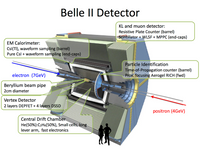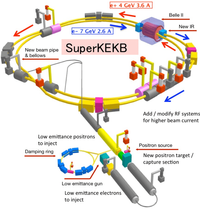The Belle II detector at the Super-KEKB collider
Belle II is a particle detector located at the interaction region of the Super-KEKB collider in Tsukuba, Japan. The aim of the experiment is to reach an unprecedented instantaneous luminosity (on the 15th of June 2020 a luminosity of 2,22 x 10³⁴/cm²/s was reached, marking a new world record) of 8x.10³⁵/cm²/s that would in turn enable scientists to perform precision measurements of the standard model and to search for very rare processes in B and D mesons as well as in tau leptons.
The Belle II detector consists of several subdetectors arranged around the beam pipe in a cylindrical structure.
The innermost subdetector is the vertex detector (VXD), which includes two layers of silicon pixels (PXD) with DEPFET technology and four outer layers of double sided silicon strips, allowing to identify with high precision the vertices of particle decays taking place within the detector.
The main tracking device is a large helium-based small-cell drift chamber (CDC) and allow to reconstruct the trajectory of charged particles.
A barrel shaped Time-of-Propagation counter (TOP) and a ring-imaging Cherenkov counters with aerogel radiator in the forward end-cap (A-RICH) allow particle identification.
The electromagnetic calorimeter (ECL) consists of a barrel and two endcaps made of CsI(Tl) crystals to detect photons and electrons/positrons thanks to their full absorption by the crystals.
A superconducting solenoid, situated outside of the electromagnetic calorimeter, provides a 1.5 T magnetic field thanks to which charged particles trajectory are bent. Finally an iron flux-return, located outside of the superconducting solenoid, which is instrumented to detect K0L mesons and to identify muons (KLM) complete the Belle II detector.









